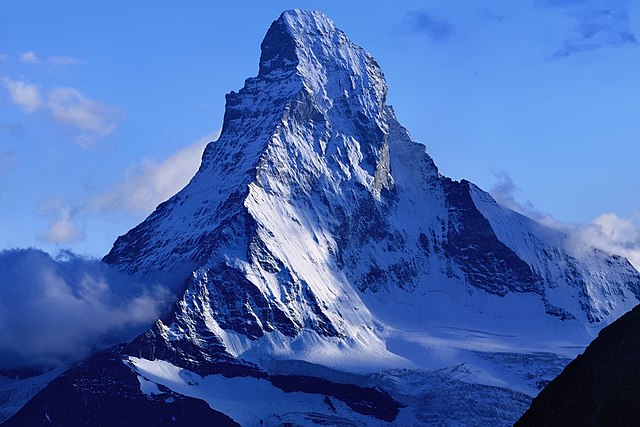 The Matterhorn, one of the world’s most iconic mountains, straddles the border between Italy and Switzerland, capturing imaginations with its pyramid-like shape and towering presence in the Alps. Rising to 4,478 meters (14,692 feet), it is renowned for its steep faces and sharp ridges, attracting mountaineers from around the world. Its unique positioning means that it is accessible from both the Swiss town of Zermatt and the Italian town of Breuil-Cervinia, drawing tourists year-round for both its scenic beauty and the challenging climb it presents.
The Matterhorn, one of the world’s most iconic mountains, straddles the border between Italy and Switzerland, capturing imaginations with its pyramid-like shape and towering presence in the Alps. Rising to 4,478 meters (14,692 feet), it is renowned for its steep faces and sharp ridges, attracting mountaineers from around the world. Its unique positioning means that it is accessible from both the Swiss town of Zermatt and the Italian town of Breuil-Cervinia, drawing tourists year-round for both its scenic beauty and the challenging climb it presents.
The mountain’s geology reveals a rich history shaped by millions of years of tectonic activity, showcasing layers of rock from both the African and Eurasian plates. This collision forced the rock layers upwards, forming the rugged Alps and ultimately the distinct silhouette of the Matterhorn. The east and north faces are in Switzerland, while the west and south faces lie in Italy, giving both countries claim to the landmark.
While the mountain’s striking beauty has made it a symbol of both countries, its allure also comes with danger. The first successful ascent, achieved by Edward Whymper and his team in 1865, ended tragically as four of the seven climbers died during descent. Today, experienced climbers still face risks on its icy ridges and technical routes, but with improved equipment and guiding expertise, many adventurers are able to experience the climb safely.
Beyond climbing, the Matterhorn area offers abundant outdoor activities like skiing, snowboarding, and hiking. Zermatt, a car-free village, is a major destination for skiers and nature enthusiasts, providing access to extensive Alpine trails and stunning viewpoints of the mountain. The Italian side, Cervinia, is similarly popular, offering expansive slopes and unique views of the Matterhorn’s southern face. In both locations, tourism plays a critical role in the local economy, and infrastructure has been developed to support large numbers of visitors, including scenic train routes, mountain huts, and guided tours.
Environmental concerns about the mountain are growing, however, as climate change affects the Alpine region. Melting permafrost has been destabilizing rock formations, increasing the risk of rockslides and making some climbing routes more hazardous. Scientists and local authorities are monitoring these changes closely, studying ways to adapt while promoting sustainable tourism to protect the natural landscape.
The Matterhorn’s cultural impact extends beyond Switzerland and Italy, as it has become a global icon. Its likeness has inspired countless works of art, logos, and even amusement park attractions, such as Disneyland’s Matterhorn Bobsleds. To this day, the mountain stands as a symbol of adventure and natural beauty, offering a connection to the majesty of the Alps and the timeless allure of mountain landscapes.
For many visitors and climbers, the Matterhorn is more than just a peak; it’s a journey into nature’s raw power, a cultural touchstone, and an invitation to experience one of Europe’s most stunning natural landmarks.

Leave a Reply
You must be logged in to post a comment.